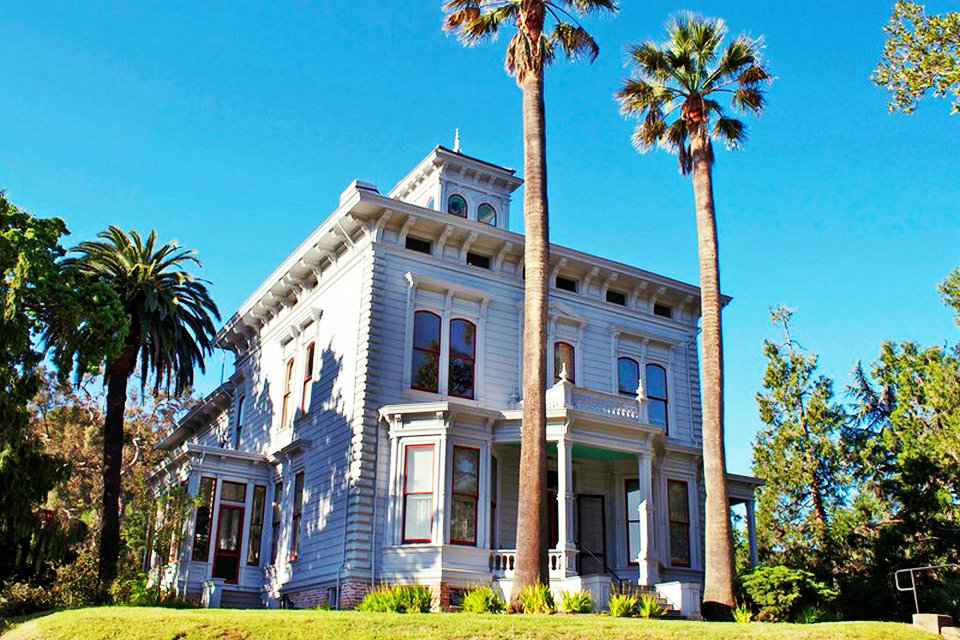John Muir National Historic Site, Martinez, United States


The John Muir National Historic Site is located in the San Francisco Bay Area, in Martinez, Contra Costa County, California. It preserves the 14-room Italianate Victorian mansion where the naturalist and writer John Muir lived, as well as a nearby 325-acre (132 ha) tract of native oak woodlands and grasslands historically owned by the Muir family. The main site is on the edge of town, in the shadow of State Route 4, also known as the “John Muir Parkway.”
John Muir (April 21, 1838 – December 24, 1914) also known as “John of the Mountains”, was a Scottish-American naturalist, author, environmental philosopher, glaciologist and early advocate for the preservation of wilderness in the United States. His letters, essays, and books describing his adventures in nature, especially in the Sierra Nevada, have been read by millions. His activism has helped to preserve the Yosemite Valley, Sequoia National Park and many other wilderness areas. The Sierra Club, which he founded, is a prominent American conservation organization. The 211-mile (340 km) John Muir Trail, a hiking trail in the Sierra Nevada, was named in his honor. Other such places include Muir Woods National Monument, Muir Beach, John Muir College, Mount Muir, Camp Muir and Muir Glacier. In Scotland, the John Muir Way, a 130-mile-long route, was named in honor of him.
In his later life, Muir devoted most of his time to the preservation of the Western forests. He petitioned the U.S. Congress for the National Park bill that was passed in 1890, establishing Yosemite National Park. The spiritual quality and enthusiasm toward nature expressed in his writings has inspired readers, including presidents and congressmen, to take action to help preserve large nature areas. Today Muir is referred to as the “Father of the National Parks” and the National Park Service has produced a short documentary about his life.
John Muir has been considered “an inspiration to both Scots and Americans”. Muir’s biographer, Steven J. Holmes, believes that Muir has become “one of the patron saints of twentieth-century American environmental activity,” both political and recreational. As a result, his writings are commonly discussed in books and journals, and he is often quoted by nature photographers such as Ansel Adams. “Muir has profoundly shaped the very categories through which Americans understand and envision their relationships with the natural world,” writes Holmes. Muir was noted for being an ecological thinker, political spokesman, and religious prophet, whose writings became a personal guide into nature for countless individuals, making his name “almost ubiquitous” in the modern environmental consciousness.
John Muir National Historic Site was established in 1964 to memorialize the man who is considered the father of the National Park Service. John Muir, through his writings and the book Our National Parks as well as personnel connections with national leaders, successfully galvanized forces to protect our nation’s wild lands and parks. He was one of the founders of the Sierra Club and was appointed the club’s president for life.
At the site in Martinez, California, the public can visit the 1882 Italianate Victorian that was John Muir’s home for the last 24 years of his life. Within this house is the “scribble den” where Muir wrote his books and articles about the natural world. The site sits on 9 acres of the original 2,600 acre orchard. Included on the site is the Martinez Adobe. The adobe was constructed in 1849 for Vicente Martinez during the period when California was a Mexican Territory.
The site consists of an additional three separate parcels of land within an approximately one-mile radius. Mount Wanda, a 326 acre grass and oak woodland is open to hikers and horseback. The land was named by John Muir for his oldest daughter Wanda. Strain Ranch consists of 186 acres and sits at the foot of Mount Wanda. The one-acre Strentzel – Muir family gravesite is the final resting place for John Muir, his wife, daughter, and in-laws.
John Muir National Historic Site has one of the world’s largest museum collections of artifacts, archives, and natural history specimens related to John Muir. The collection is critical in providing a tangible link to Muir’s life and work through educational programs, research opportunities, and through both virtual and onsite/offsite exhibition. The park plays a role in increasing the understanding of Muir’s significance and perpetuating his legacy through cooperation with institutions containing related collections and others vested in John Muir’s legacy.
The mansion was built in 1883 by Dr. John Strentzel, Muir’s father-in-law, with whom Muir went into partnership, managing his 2,600-acre (1,100 ha) fruit ranch. Muir and his wife, Louisa, moved into the house in 1890, and he lived there until his death in 1914.
While living here, Muir realized many of his greatest accomplishments, co-founding and serving as the first president of the Sierra Club, in the wake of his battle to prevent Yosemite National Park’s Hetch Hetchy Valley from being dammed, playing a prominent role in the creation of several national parks, writing hundreds of newspaper and magazine articles and several books expounding on the virtues of conservation and the natural world, and laying the foundations for the creation of the National Park Service in 1916.
The home contains Muir’s “scribble den,” as he called his study, and his original desk, where he wrote about many of the ideas that are the bedrock of the modern conservation movement.
The Muir house was documented by the Historic American Buildings Survey in 1960.
It became a National Historic Site in 1964, is a California Historical Landmark #312 and National Historic Landmark, and is on the National Register of Historic Places.
In 1988 nearby Mount Wanda Nature Preserve was added to the Historic Site.